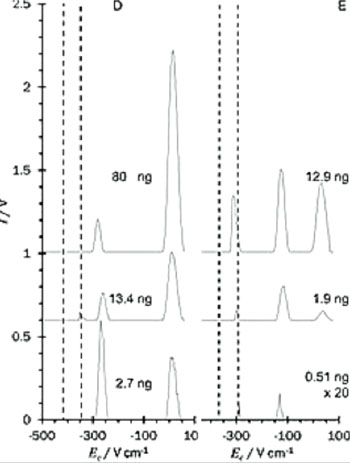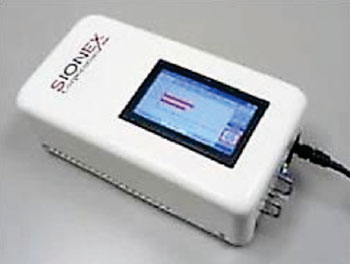Saliva Test Detects GHB and Alcohol Poisonings
|
By LabMedica International staff writers Posted on 19 Jan 2016 |

Image: Differential mobility spectra extracted from the GC-DMS response surface for 1,3-propandiol (D) and GHB (E) (Photo courtesy of Loughborough University).

Image: The Sionex microanalyzer trace chemical detection system (Photo courtesy of Sionex Corporation).
A saliva-based test has been developed that offers the potential to screen for poisons commonly associated with the cheap or imitation manufacture of alcohol, and γ-hydroxybutyric acid, the so-called “date rape” drug GHB.
Treatment of poisoning from the consumption of ethanol and the management of the intoxicated patient represents a significant burden on many health services. Further, poisoning from the consumption of other alcohols, notably methanol and ethylene glycol, occurs sporadically and from time to time outbreaks occur where food, drink or medicines are contaminated, resulting in significant mortality.
Scientists at Loughborough University (UK) and the University of Cordoba (Spain) added to the fresh saliva of volunteers and used a polydimethylsiloxane (PDMS) oral sampler to extract methanol, ethanol, ethylene glycol, 1,3-propandiol and γ-hydroxybutyric acid. The compounds were detected using gas chromatography-differential mobility spectrometry (GC-DMS). The extracted compounds were recovered by thermal desorption, isolated by gas chromatography and detected with differential mobility spectrometry, operating with a programmed dispersion field.
Calibration of the DMS under optimized conditions was undertaken using gas chromatography to introduce known on-column masses of the analytes injected in a solution of dichloromethane. The DMS used in the study was a planar device (SDP-1, Sionex Corporation, Bedford, MA, USA). Once the analytes had been added, the saliva standards were homogenized. Immediately after this had been done, a PDMS-coated titanium cartridge was removed from its sealed thermal desorption tube and placed into the vial, which was then sealed immediately.
C.L. Paul Thomas, PhD, a professor of Analytical Science, and coauthor of the study, said, “Many people attending accident and emergency departments have some kind of alcohol-related issue, particularly at the weekends. We're aiming to develop a test that is as simple as taking temperature with a thermometer that detects when patients are more than just drunk. We were surprised at the ease at which we could detect γ-hydroxybutyric acid. It's both a polar and acidic molecule, but it turned out to be easy to detect, even at the low concentrations we were studying.” The scientists are now working on running trials of their test in a clinical setting, on patients in emergency departments. The study was published on January 8, 2016, in the Journal of Breath Research.
Related Links:
Loughborough University
University of Cordoba
Treatment of poisoning from the consumption of ethanol and the management of the intoxicated patient represents a significant burden on many health services. Further, poisoning from the consumption of other alcohols, notably methanol and ethylene glycol, occurs sporadically and from time to time outbreaks occur where food, drink or medicines are contaminated, resulting in significant mortality.
Scientists at Loughborough University (UK) and the University of Cordoba (Spain) added to the fresh saliva of volunteers and used a polydimethylsiloxane (PDMS) oral sampler to extract methanol, ethanol, ethylene glycol, 1,3-propandiol and γ-hydroxybutyric acid. The compounds were detected using gas chromatography-differential mobility spectrometry (GC-DMS). The extracted compounds were recovered by thermal desorption, isolated by gas chromatography and detected with differential mobility spectrometry, operating with a programmed dispersion field.
Calibration of the DMS under optimized conditions was undertaken using gas chromatography to introduce known on-column masses of the analytes injected in a solution of dichloromethane. The DMS used in the study was a planar device (SDP-1, Sionex Corporation, Bedford, MA, USA). Once the analytes had been added, the saliva standards were homogenized. Immediately after this had been done, a PDMS-coated titanium cartridge was removed from its sealed thermal desorption tube and placed into the vial, which was then sealed immediately.
C.L. Paul Thomas, PhD, a professor of Analytical Science, and coauthor of the study, said, “Many people attending accident and emergency departments have some kind of alcohol-related issue, particularly at the weekends. We're aiming to develop a test that is as simple as taking temperature with a thermometer that detects when patients are more than just drunk. We were surprised at the ease at which we could detect γ-hydroxybutyric acid. It's both a polar and acidic molecule, but it turned out to be easy to detect, even at the low concentrations we were studying.” The scientists are now working on running trials of their test in a clinical setting, on patients in emergency departments. The study was published on January 8, 2016, in the Journal of Breath Research.
Related Links:
Loughborough University
University of Cordoba
Latest Clinical Chem. News
- 3D Printed Point-Of-Care Mass Spectrometer Outperforms State-Of-The-Art Models
- POC Biomedical Test Spins Water Droplet Using Sound Waves for Cancer Detection
- Highly Reliable Cell-Based Assay Enables Accurate Diagnosis of Endocrine Diseases
- New Blood Testing Method Detects Potent Opioids in Under Three Minutes
- Wireless Hepatitis B Test Kit Completes Screening and Data Collection in One Step
- Pain-Free, Low-Cost, Sensitive, Radiation-Free Device Detects Breast Cancer in Urine
- Spit Test Detects Breast Cancer in Five Seconds
- Electrochemical Sensors with Next-Generation Coating Advances Precision Diagnostics at POC
- First-Of-Its-Kind Handheld Device Accurately Detects Fentanyl in Urine within Seconds
- New Fluorescent Sensor Array Lights up Alzheimer’s-Related Proteins for Earlier Detection
- Automated Mass Spectrometry-Based Clinical Analyzer Could Transform Lab Testing
- Highly Sensitive pH Sensor to Aid Detection of Cancers and Vector-Borne Viruses
- Non-Invasive Sensor Monitors Changes in Saliva Compositions to Rapidly Diagnose Diabetes
- Breakthrough Immunoassays to Aid in Risk Assessment of Preeclampsia
- Urine Test for Monitoring Changes in Kidney Health Markers Can Predict New-Onset Heart Failure
- AACC Releases Comprehensive Diabetes Testing Guidelines
Channels
Molecular Diagnostics
view channelBlood Proteins Could Warn of Cancer Seven Years before Diagnosis
Two studies have identified proteins in the blood that could potentially alert individuals to the presence of cancer more than seven years before the disease is clinically diagnosed. Researchers found... Read moreUltrasound-Aided Blood Testing Detects Cancer Biomarkers from Cells
Ultrasound imaging serves as a noninvasive method to locate and monitor cancerous tumors effectively. However, crucial details about the cancer, such as the specific types of cells and genetic mutations... Read moreHematology
view channel
Next Generation Instrument Screens for Hemoglobin Disorders in Newborns
Hemoglobinopathies, the most widespread inherited conditions globally, affect about 7% of the population as carriers, with 2.7% of newborns being born with these conditions. The spectrum of clinical manifestations... Read more
First 4-in-1 Nucleic Acid Test for Arbovirus Screening to Reduce Risk of Transfusion-Transmitted Infections
Arboviruses represent an emerging global health threat, exacerbated by climate change and increased international travel that is facilitating their spread across new regions. Chikungunya, dengue, West... Read more
POC Finger-Prick Blood Test Determines Risk of Neutropenic Sepsis in Patients Undergoing Chemotherapy
Neutropenia, a decrease in neutrophils (a type of white blood cell crucial for fighting infections), is a frequent side effect of certain cancer treatments. This condition elevates the risk of infections,... Read more
First Affordable and Rapid Test for Beta Thalassemia Demonstrates 99% Diagnostic Accuracy
Hemoglobin disorders rank as some of the most prevalent monogenic diseases globally. Among various hemoglobin disorders, beta thalassemia, a hereditary blood disorder, affects about 1.5% of the world's... Read moreImmunology
view channel.jpg)
AI Predicts Tumor-Killing Cells with High Accuracy
Cellular immunotherapy involves extracting immune cells from a patient's tumor, potentially enhancing their cancer-fighting capabilities through engineering, and then expanding and reintroducing them into the body.... Read more
Diagnostic Blood Test for Cellular Rejection after Organ Transplant Could Replace Surgical Biopsies
Transplanted organs constantly face the risk of being rejected by the recipient's immune system which differentiates self from non-self using T cells and B cells. T cells are commonly associated with acute... Read more
AI Tool Precisely Matches Cancer Drugs to Patients Using Information from Each Tumor Cell
Current strategies for matching cancer patients with specific treatments often depend on bulk sequencing of tumor DNA and RNA, which provides an average profile from all cells within a tumor sample.... Read more
Genetic Testing Combined With Personalized Drug Screening On Tumor Samples to Revolutionize Cancer Treatment
Cancer treatment typically adheres to a standard of care—established, statistically validated regimens that are effective for the majority of patients. However, the disease’s inherent variability means... Read moreMicrobiology
view channel
Integrated Solution Ushers New Era of Automated Tuberculosis Testing
Tuberculosis (TB) is responsible for 1.3 million deaths every year, positioning it as one of the top killers globally due to a single infectious agent. In 2022, around 10.6 million people were diagnosed... Read more
Automated Sepsis Test System Enables Rapid Diagnosis for Patients with Severe Bloodstream Infections
Sepsis affects up to 50 million people globally each year, with bacteraemia, formerly known as blood poisoning, being a major cause. In the United States alone, approximately two million individuals are... Read moreEnhanced Rapid Syndromic Molecular Diagnostic Solution Detects Broad Range of Infectious Diseases
GenMark Diagnostics (Carlsbad, CA, USA), a member of the Roche Group (Basel, Switzerland), has rebranded its ePlex® system as the cobas eplex system. This rebranding under the globally renowned cobas name... Read more
Clinical Decision Support Software a Game-Changer in Antimicrobial Resistance Battle
Antimicrobial resistance (AMR) is a serious global public health concern that claims millions of lives every year. It primarily results from the inappropriate and excessive use of antibiotics, which reduces... Read morePathology
view channelHyperspectral Dark-Field Microscopy Enables Rapid and Accurate Identification of Cancerous Tissues
Breast cancer remains a major cause of cancer-related mortality among women. Breast-conserving surgery (BCS), also known as lumpectomy, is the removal of the cancerous lump and a small margin of surrounding tissue.... Read more
AI Advancements Enable Leap into 3D Pathology
Human tissue is complex, intricate, and naturally three-dimensional. However, the thin two-dimensional tissue slices commonly used by pathologists to diagnose diseases provide only a limited view of the... Read more
New Blood Test Device Modeled on Leeches to Help Diagnose Malaria
Many individuals have a fear of needles, making the experience of having blood drawn from their arm particularly distressing. An alternative method involves taking blood from the fingertip or earlobe,... Read more
Robotic Blood Drawing Device to Revolutionize Sample Collection for Diagnostic Testing
Blood drawing is performed billions of times each year worldwide, playing a critical role in diagnostic procedures. Despite its importance, clinical laboratories are dealing with significant staff shortages,... Read moreTechnology
view channel
New Diagnostic System Achieves PCR Testing Accuracy
While PCR tests are the gold standard of accuracy for virology testing, they come with limitations such as complexity, the need for skilled lab operators, and longer result times. They also require complex... Read more
DNA Biosensor Enables Early Diagnosis of Cervical Cancer
Molybdenum disulfide (MoS2), recognized for its potential to form two-dimensional nanosheets like graphene, is a material that's increasingly catching the eye of the scientific community.... Read more
Self-Heating Microfluidic Devices Can Detect Diseases in Tiny Blood or Fluid Samples
Microfluidics, which are miniature devices that control the flow of liquids and facilitate chemical reactions, play a key role in disease detection from small samples of blood or other fluids.... Read more
Breakthrough in Diagnostic Technology Could Make On-The-Spot Testing Widely Accessible
Home testing gained significant importance during the COVID-19 pandemic, yet the availability of rapid tests is limited, and most of them can only drive one liquid across the strip, leading to continued... Read moreIndustry
view channel
Danaher and Johns Hopkins University Collaborate to Improve Neurological Diagnosis
Unlike severe traumatic brain injury (TBI), mild TBI often does not show clear correlations with abnormalities detected through head computed tomography (CT) scans. Consequently, there is a pressing need... Read more
Beckman Coulter and MeMed Expand Host Immune Response Diagnostics Partnership
Beckman Coulter Diagnostics (Brea, CA, USA) and MeMed BV (Haifa, Israel) have expanded their host immune response diagnostics partnership. Beckman Coulter is now an authorized distributor of the MeMed... Read more_1.jpg)











_1.jpg)
.jpg)
